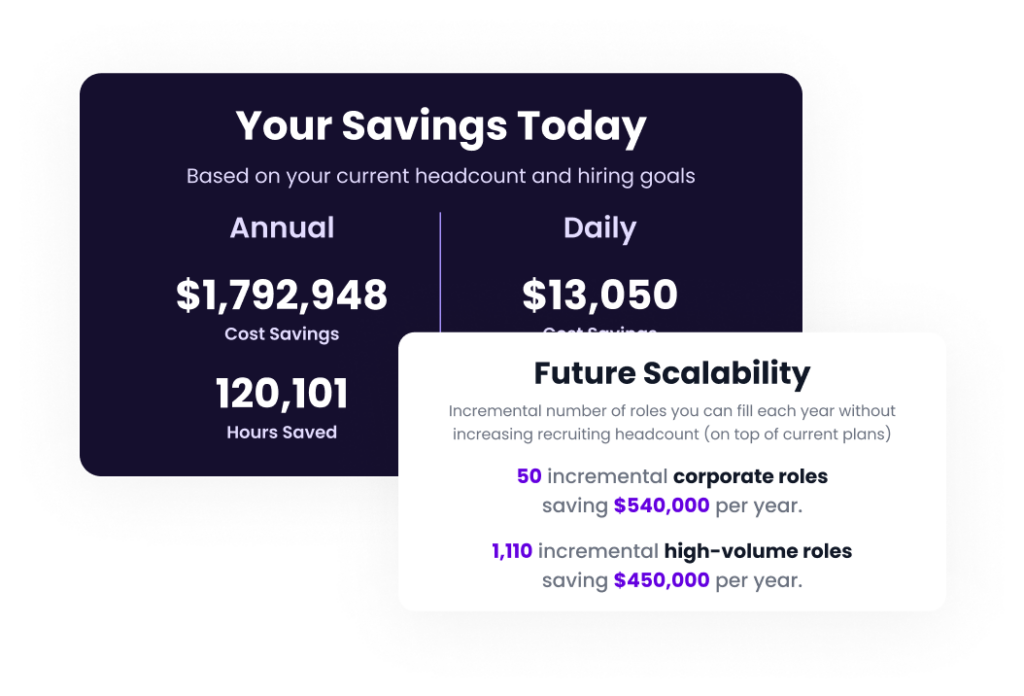Many talent teams successfully waded their way through a muck of unpredictability over the last few years — just to be met with more challenges on the other side. But the truth is — hiring will always be a challenge, won’t it?
Talent teams today are leaner and meaner than they’ve had to be in a long time, yet are striving for the same results they got with budgets twice as big. So how do hiring teams tackle the current landscape head-on so they can find the quality talent they so desperately need?
We spoke with the experts who are keeping TA efforts resilient at their companies. In this article, we’ll cover the biggest challenges hiring teams are facing today — plus, expert tips for overcoming these hiring challenges moving forward.
In some industries, there’s still a shortage of talent
Where did all the talent go?
This is a question that hiring leaders across the globe are still grappling with — especially in industries like healthcare, retail, and manufacturing.
In the case of these high-volume industries, there’s simply a shortage of qualified talent. For other industries like tech, we’re not saying quality candidates aren’t out there. They are. However, talent teams are still struggling to attract the right candidates, the right way.
GoodTime recently surveyed over 500 TA leaders in the U.S. and found that 24% of respondents identified a lack of qualified candidates as one of their top hiring challenges. These same survey respondents ranked quality-of-hire as their top focus in hiring metrics — so clearly it’s top of mind.
So why are qualified candidates so hard to find?
For starters, it’s important to understand that candidates have changed. And with that change comes a new set of demands.
The newest generation of job seekers has no desire to work 20 to 30 years in the same position. They’re looking for a place that meets their expectations, and honestly, they’re not willing to settle. So if companies aren’t bringing their A game, talent will say no.

Unlock 2026’s top hiring strategies: Insights from 500+ TA leaders
Be the first to uncover deep hiring insights specific to your sector — straight from the highest-performing TA teams.

What can you do?
There’s one thing talent leaders need to understand: using past solutions to fix future problems won’t work. It’s a new world of work and with that comes new hiring strategies.
But to really understand how to fix the lack of quality talent, we must first address the challenges below. Once these common challenges are handled, top talent will not be so hard to come by.
There’s a growing skills mismatch
Skills have become a hot topic in the hiring industry — and rightfully so. With the rapid development and implementation of new technology, we’re seeing a gap between the skills candidates possess and the skills they need to operate and innovate in the modern economy.
But when we talk about skills, it’s more than just technical skills. Soft skills, such as adaptability, problem-solving, and communication, have become equally important in the workforce. With the right skills, workers can adapt and change as quickly as our environment is changing.
To add to the skills gap dilemma, hiring teams are also running into another skills issue — padded resumes. In fact, it’s the top hiring challenge our survey respondents experienced over the last 12 months. One in four companies said that candidates padded their resumes, making it difficult to know who they are really hiring.
With the rise of AI technology, like Chat GPT, candidates may use it to write their resumes and cover letters, or even to aid them live during an interview. The problem is that candidates often fail to fact-check these tools. Whether padded resumes are intentional or not, tightening up how candidates are assessed for skills is critical right now. And that starts with standardization
What can you do?
Define a clear standardized process for selecting and vetting candidates. Then, train your interviewers on how to ask the right questions for certain skills. Additionally, an interviewer selection tool can quickly find the best interviewer based on the skills you need.
We spoke with veteran recruiting consultant Jenny Jongejan about tech hiring challenges and the right way to identify and vet candidates and she emphasized the importance of standardizing the entire process, including the questions your interviewers ask: “Before you even open a role and begin sourcing, it’s so important to know why you’re hiring. What are the business objectives that the role is going to impact? So if this is a software engineer position, is it a backfill, is it a skills gap? Are you up-leveling the team with somebody who has more leadership skills? Or, is it a new product and you need someone with niche skills?”
Jenny went on to share how having that conversation about qualifications up front will inform the questions you ask: “Based on those predetermined skills and behavioral attributes, figure out exactly who on your interview panel is going to be able to evaluate the candidate on those particular focus areas and assign the right focus areas to the right interviewers and even assign them the questions that they will ask every candidate.
I know sounds incredibly prescribed, but, research does show that structured interviews are 81% more accurate in predicting job performance than unstructured ones. So having a set of standard questions that interviewers ask every candidate really ensures that interviewers don’t insert their own biased set of criteria and leads to better hires.”
The last step is making sure that you’re having a productive, clear post-interview debrief with the hiring team.
If you can’t find the right candidates with the right skills, consider upskilling current employees. Training and development is one of the best ways to retain current employees and build a pipeline of skilled workers.
You may also consider looking beyond traditional sources of recruitment and explore other options, such as freelancers or contractors. Not only does this open the doors to a more diverse team, but it’s likely that you’ll find what you’re looking for simply by expanding your search.
Having a set of standard questions that interviewers ask every candidate really ensures that interviewers don’t insert their own biased set of criteria and leads to better hires.
Jenny Jongejan, Senior Recruiting Consultant
Opinions on work flexibility are polarized
In the last few years, there’s been a dynamic shift in where and when we work — largely due to the pandemic. Once things settled, many employers tried to force their employees back to set hours and a set office space while others embraced the change as the new normal.
The reality is that candidates demand flexibility, whether that’s working remotely or just the ability to come and go from the office as they please.
And truthfully, this is no surprise to employers. More than half of the TA leaders we surveyed said flexibility is their biggest selling point when it comes to attracting top talent.
With that in mind, organizations need to adopt and embrace a flexible working model so candidates don’t take their skills elsewhere.
What can you do?
A successful work model is more than simply allowing remote work or flexible office hours.
Employers must first listen to the needs of their employees. Then, build a set of guidelines that give employees greater freedom to decide when, where, and how to work.
There’s not a one-size-fits-all flexible work model. Every industry and every employee is different. What one employee wants may not be what another one wants. A flexible work model that works for your company will likely take some adaptability and experimentation.
However, the best model for workplace flexibility will always balance the needs of employees with the company’s goals — fostering an atmosphere of engagement, productivity, and adaptability.
There’s no question that technology should play a part in this workplace model. With tech, employers can address scheduling, productivity, and communication. And in hiring, tech can help assess the candidate’s ability to be successful in remote, hybrid, or flexible working schedules.
Time-to-hire has increased
We’re a generation that has zero patience for lag time. And with the rise of high-speed technology, this impatience has only compounded.
So it may be a little surprising to hear that it’s actually taking TA teams longer to hire, not shorter. Yes, Josh Bersin’s newest report recently reported 44 days to fill a vacant spot. This is up from 43 days just a year ago.
GoodTime’s survey shows the same results, with 71% of TA leaders saying their time-to-hire has increased in the last year — up from 60% just a year earlier.
If we step back for a minute and take a look at what’s happened over the last few years, we can see a couple of factors play into this.
With the struggle to land quality talent, employers are slowing down and making more calculated decisions — rather than just trying to fill empty seats fast. On the other end of the spectrum, talent is more picky and won’t jump into a job unless it offers perks, like flexibility and upskilling opportunities.
It feels like leaders are put between a rock and a hard place, especially since 49% of job seekers say they’ve turned down a job offer due to a bad hiring experience.
71% of TA leaders reported that their time-to-hire increased in 2022 — up from 60% just a year earlier.
GoodTime’s 2023 Hiring Insights Report
What can you do?
Time-to-hire matters. If you’re not tracking it, you should be. We asked Dallas Frazer, the former Recruitment Operations Lead at Shopify and current Senior Customer Success Manager at GoodTime, about the importance of time-to-hire and how to use it to improve your hiring process.
Here’s what Dallas had to say: “One of the key metrics recruiters will want to track is time-to-hire. If you find your process dragging on for longer than necessary, it’s a clear sign you might be investing too much time and effort in certain stages. It’s also crucial to compare these timings across different roles for context. If time-to-hire is consistently higher for one role type versus another, it’s worth looking into and saying what part of that role’s hiring process isn’t working. What can you learn from other roles with a faster time-to-hire?”
But of course, time-to-hire is only important as a way to ensure you’re securing the right talent for the right role. The more seamless the hiring process, the more appealing your company looks to top candidates.
How do you get that seamless hiring process? Start by using tech to maximize your resources and complete tasks in half the time. A great example of this is automated scheduling. Our survey shows that there was a 5% increase in interview scheduling time over the last year — something that can easily be fixed with the right interview scheduling software.
Automation takes over time-consuming tasks so talent teams can focus on getting top candidates to the final offer much faster. Yes, you can simultaneously focus on hiring speed and quality hire.
Does interview scheduling automation make sense for my team?
ROI is key. This is not a time to invest in software that won’t bring you immediate value. So let’s eliminate the guesswork with our free ROI calculator.

Technology is constantly evolving
When asked what challenges they expect in the next 12 months, 27% of our survey respondents ranked “limitations in their current hiring technology” as their top concern.
As technology quickly advances, the fear that their current technology won’t keep up is definitely valid. Especially since technology is changing how companies hire — and if you don’t keep up, you’ll lose your talent to those who do.
But with all the options out there, it’s hard to know what your organization needs to excel.
What can you do?
We spoke with Jonathon Wall, a seasoned TA professional with over 20 years of experience leading recruiting teams, about what TA pros can do to keep up with evolving tech. He told us, “If you’re not upskilling, if you’re not preparing yourself for what’s next, you’re probably falling behind. If you’re not ready to really take advantage of the scalability that you get with automation and AI, watch out because somebody is.”
But it wasn’t just a warning. Jonathon is very optimistic about the potential these tools have to improve the lives of recruiters: “We should be leveraging automation and AI to do those things that aren’t fun — the repetitive tasks. Leverage all of those tools so that you can have higher-quality human interactions. And If you’re not leveraging those tools, then you’re really draining all of that life force, the energy that you’re going to share with candidates, and the enthusiasm that you’re gonna bring to your profession.”
You can watch the highlights of our conversation below:
Automation and AI recruiting tools can quickly and efficiently streamline the recruitment process. But every company is different so it’s critical to understand your needs and adopt the tools that will boost your hiring experience.
39% percent of our survey respondents said they worked to improve the overall efficiency of their hiring process in the last year. It’s a great start, but there’s still lots of work to do.
As we look to 2024 and beyond, hiring teams need to be agile and quick to react as the workplace constantly evolves. This means staying on top of the most current technology to speed efficiency and land quality talent.
If you’re not preparing yourself for what’s next, you’re probably falling behind.
Jonathon Wall, Principal, The Cassillon Group, Inc.
Stay adaptable in 2024 and beyond
If you only take one thing away from this article, it should be that the number one determinant of TA success in 2024 will be your ability to adapt to change.
If you haven’t done so already, it’s time to standardize your interview and hiring processes, embrace work flexibility as a key selling point, and address the prolonged time-to-hire issue through technology-driven solutions.
With GoodTime Hire, you can speed up your hiring process and land top talent 50% faster. Our smart scheduling automation streamlines the interview process so talent teams can focus on what they really enjoy — hiring the right people!
Want to know more? See how GoodTime’s interview scheduling software can transform your recruiting process today.




